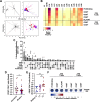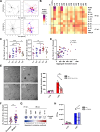Soluble immune mediators orchestrate protective in vitro granulomatous responses across Mycobacterium tuberculosis complex lineages
- PMID: 40162896
- PMCID: PMC11957536
- DOI: 10.7554/eLife.99062
Soluble immune mediators orchestrate protective in vitro granulomatous responses across Mycobacterium tuberculosis complex lineages
Abstract
The members of the Mycobacterium tuberculosis complex (MTBC) causing human tuberculosis comprise 10 phylogenetic lineages that differ in their geographical distribution. The human consequences of this phylogenetic diversity remain poorly understood. Here, we assessed the phenotypic properties at the host-pathogen interface of 14 clinical strains representing five major MTBC lineages. Using a human in vitro granuloma model combined with bacterial load assessment, microscopy, flow cytometry, and multiplexed-bead arrays, we observed considerable intra-lineage diversity. Yet, modern lineages were overall associated with increased growth rate and more pronounced granulomatous responses. MTBC lineages exhibited distinct propensities to accumulate triglyceride lipid droplets-a phenotype associated with dormancy-that was particularly pronounced in lineage 2 and reduced in lineage 3 strains. The most favorable granuloma responses were associated with strong CD4 and CD8 T cell activation as well as inflammatory responses mediated by CXCL9, granzyme B, and TNF. Both of which showed consistent negative correlation with bacterial proliferation across genetically distant MTBC strains of different lineages. Taken together, our data indicate that different virulence strategies and protective immune traits associate with MTBC genetic diversity at lineage and strain level.
Keywords: Mycobacterium tuberculosis complex; granuloma; host-pathogen interaction; immunology; infectious disease; inflammation; lineage; microbiology; mycobacterium tuberculosis complex; tuberculosis; virulence.
© 2024, Arbués et al.
Conflict of interest statement
AA, SS, MR, SB, SG, DP No competing interests declared
Figures
















Update of
- doi: 10.1101/2024.05.21.595219
- doi: 10.7554/eLife.99062.1
- doi: 10.7554/eLife.99062.2
- doi: 10.7554/eLife.99062.3
References
-
- Andrews JT, Zhang Z, Prasad G, Huey F, Nazarova EV, Wang J, Ranaraja A, Weinkopff T, Li LX, Mu S, Birrer MJ, Huang SCC, Zhang N, Argüello RJ, Philips JA, Mattila JT, Huang L. Metabolically active neutrophils represent a permissive niche for Mycobacterium tuberculosis. Mucosal Immunology. 2024;17:825–842. doi: 10.1016/j.mucimm.2024.05.007. - DOI - PMC - PubMed
MeSH terms
Grants and funding
LinkOut - more resources
Full Text Sources
Medical
Research Materials

